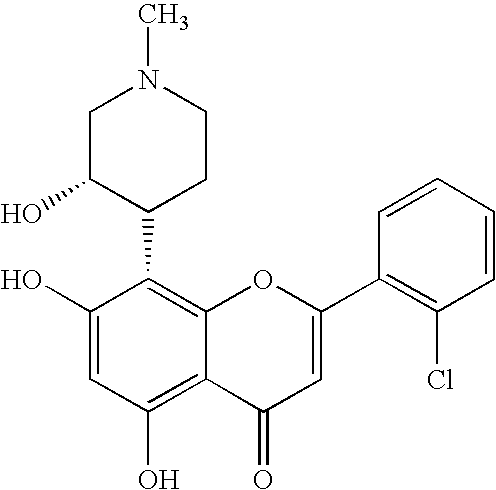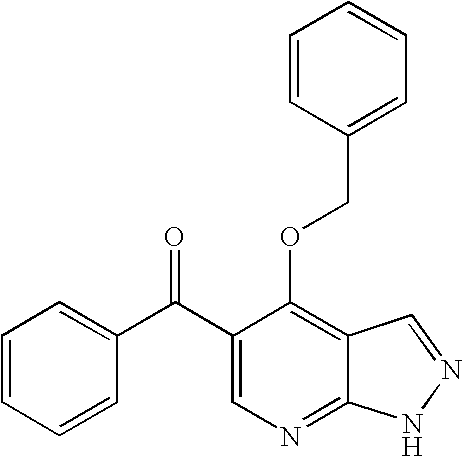2-aminothiazole-4-carboxylic amides as protein kinase inhibitors
a technology of aminothiazole and carboxylic amide, which is applied in the field of anilinopiperazine derivatives, can solve the problems of increased cdk2 activity, poor overall survival, and inducible apoptosis (programmed cell death)
- Summary
- Abstract
- Description
- Claims
- Application Information
AI Technical Summary
Benefits of technology
Problems solved by technology
Method used
Image
Examples
example 1
Preparation of Compound 1
[0445]
[0446]To a solution of 2-phenylamino-thiazole-4-carboxylic acid (0.1 mmol), N,N-diisopropylethylamine (0.50 mmol, 87 μL) and HATU (0.10 mmol, 38 mg) in DMF (2 mL) was added 4-(2-aminophenyl)-piperazine-1-carboxylic acid tert-butyl ester (0.10 mmol, 28 mg). The resulting reaction was heated to 80° C. and allowed to stir at this temperature for 15 hours. The reaction was cooled to room temperature, then concentrated in vacuo. The resulting solid residue was treated with TFA (0.5 mL) and the resulting solution was allowed to stir at room temperature for 10 minutes, then concentrated in vacuo. The resulting residue was dissolved in DMSO / acetonitrile (3:1), purified using reverse phase HPLC to provide Compound 1.
example 2
Preparation of Compound 2
[0447]
[0448]K3PO4(0.10 mmol, 21 mg) and the solution of Pd2(dba)3 (5.0 μmol, 4.6 mg), Xantphos (0.010 mmol, 5.8 mg) and aryl bromide (0.050 mmol, 23 mg) in dioxane (1 mL) were added into a tube containing a stir bar. The tube was flushed with nitrogen. N-Methylaniline (11 mg, 0.10 mmol) was added into the tube via a syringe under a N2 atmosphere. The tube was sealed tightly and put into an oil bath at 100° C. The reaction mixture was stirred at 100° C. for 15 hours, and then cooled to room temperature. The mixture was filtered through celite with the assistance of dichloromethane. The solution was concentrated, and the residue was reacted with TFA (0.5 mL) for 10 min. The TFA solution was concentrated in vacuo. The desired product was purified using reverse phase HPLC.
example 3
Preparation of Compound 3
[0449]
[0450]A solution of 2-bromo-thiazole-4-carboxylic acid (2-piperazin-1-yl-phenyl)-amide (0.050 mmol, 23 mg), N,N-diisopropylethylamine (0.20 mmol, 35 μL) and benzylmethyl amine (0.1 mmol) in DMF (1 mL) was irradiated using microwave for 15 minutes at a temperature of 180° C. The reaction mixture was then concentrated, and the resulting residue was treated with TFA (0.5 mL) with stirring for 10 minutes. The TFA solution was concentrated in vacuo and the resulting residue was purified using reverse phase HPLC to provide Compound 3.
PUM
| Property | Measurement | Unit |
|---|---|---|
| temperature | aaaaa | aaaaa |
| column temperature | aaaaa | aaaaa |
| temperature | aaaaa | aaaaa |
Abstract
Description
Claims
Application Information
 Login to View More
Login to View More - R&D
- Intellectual Property
- Life Sciences
- Materials
- Tech Scout
- Unparalleled Data Quality
- Higher Quality Content
- 60% Fewer Hallucinations
Browse by: Latest US Patents, China's latest patents, Technical Efficacy Thesaurus, Application Domain, Technology Topic, Popular Technical Reports.
© 2025 PatSnap. All rights reserved.Legal|Privacy policy|Modern Slavery Act Transparency Statement|Sitemap|About US| Contact US: help@patsnap.com



